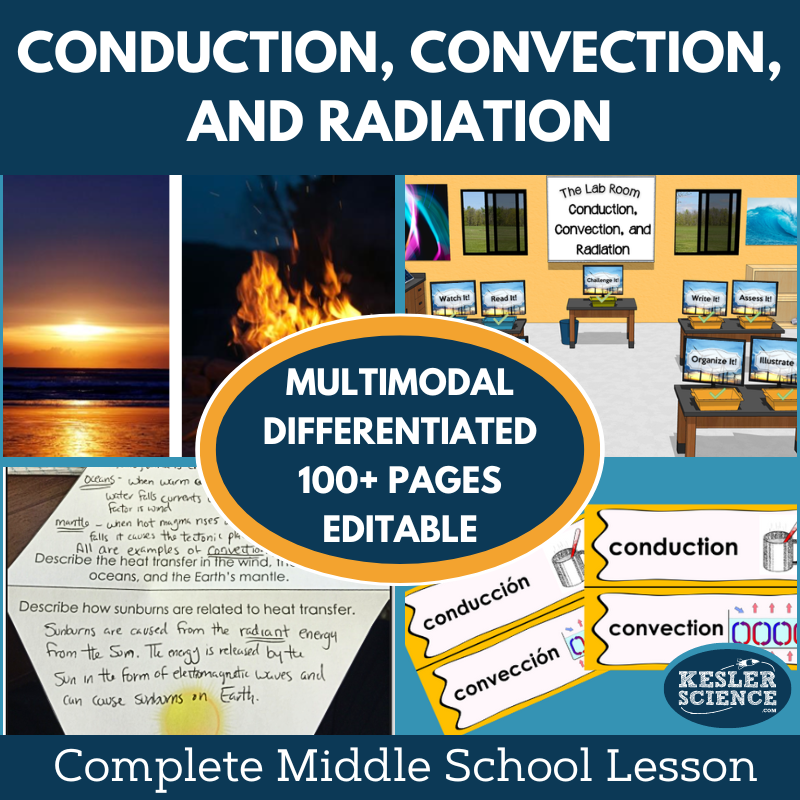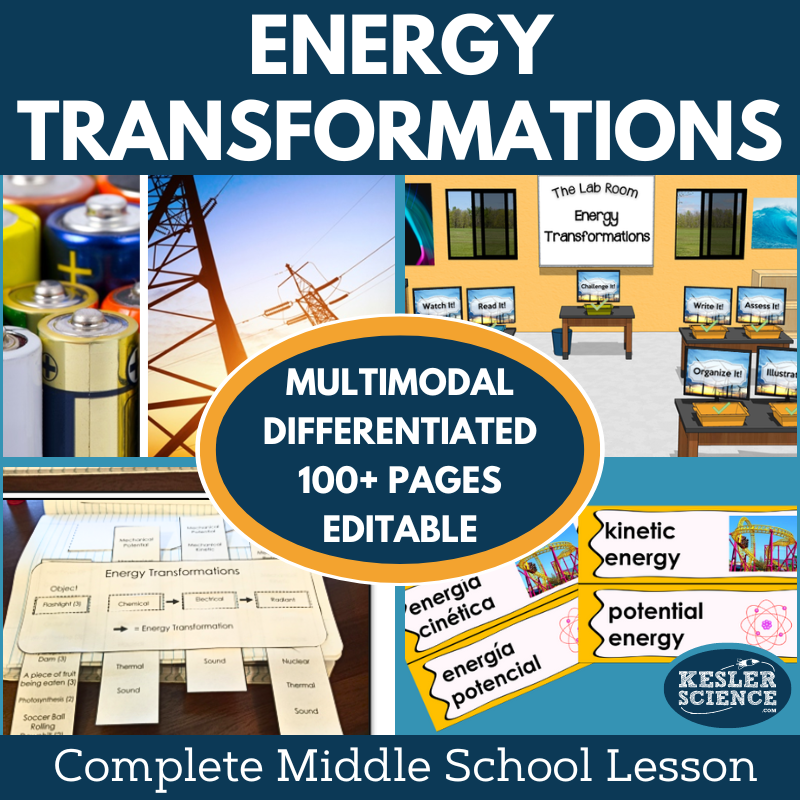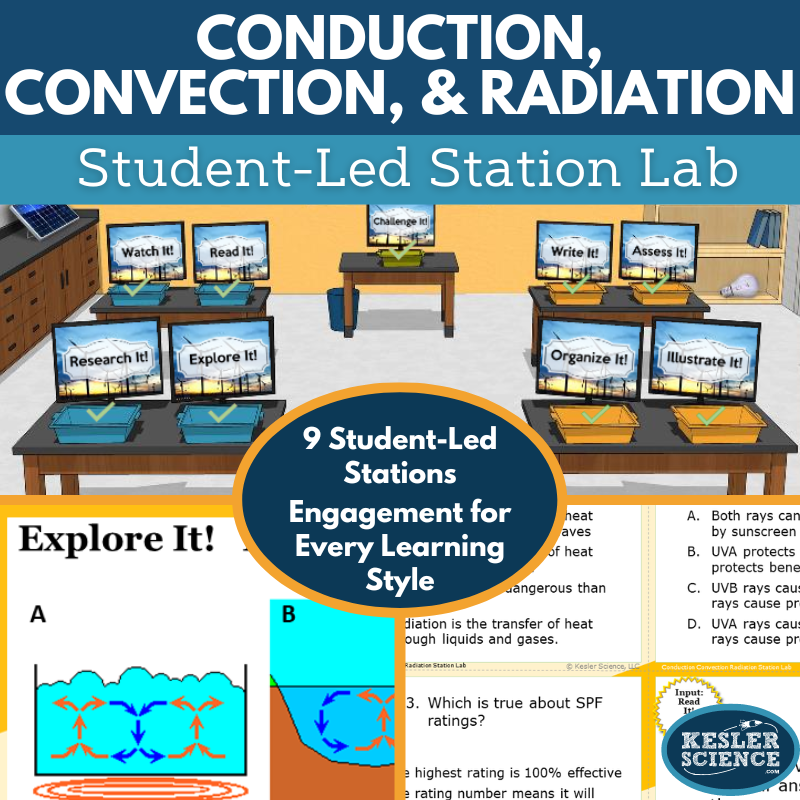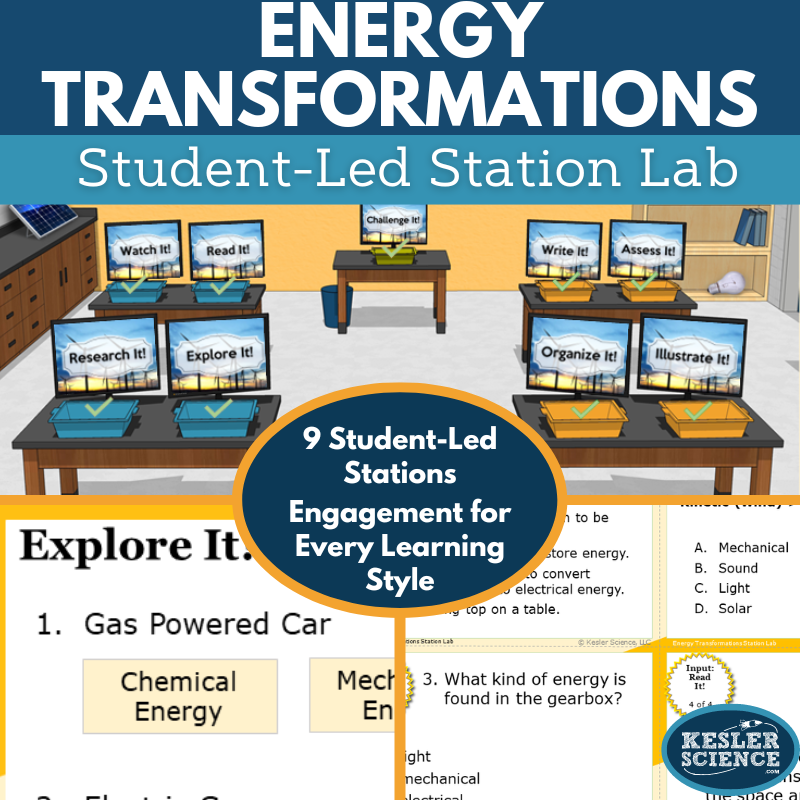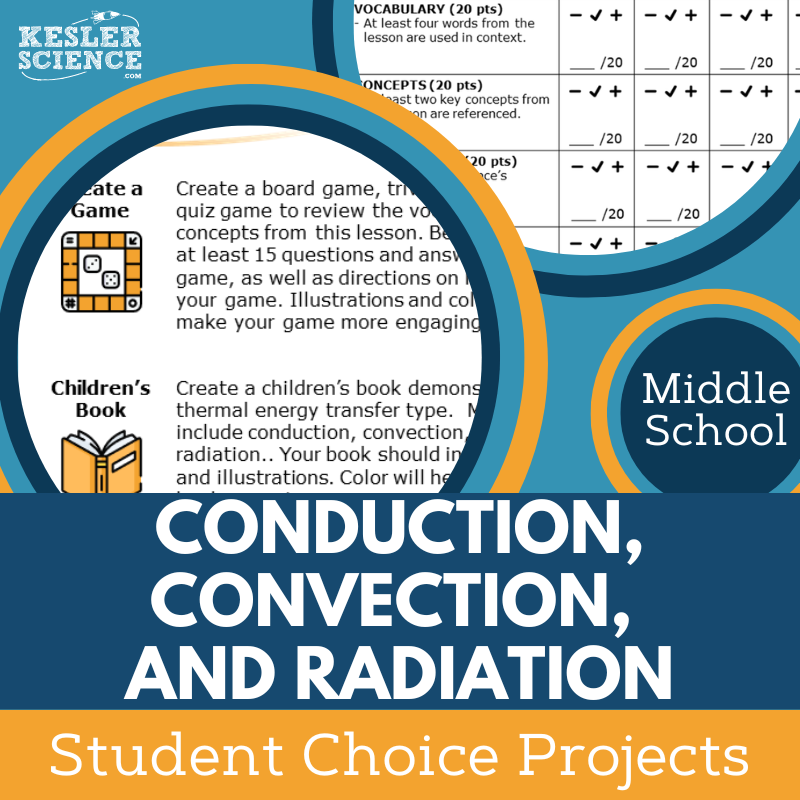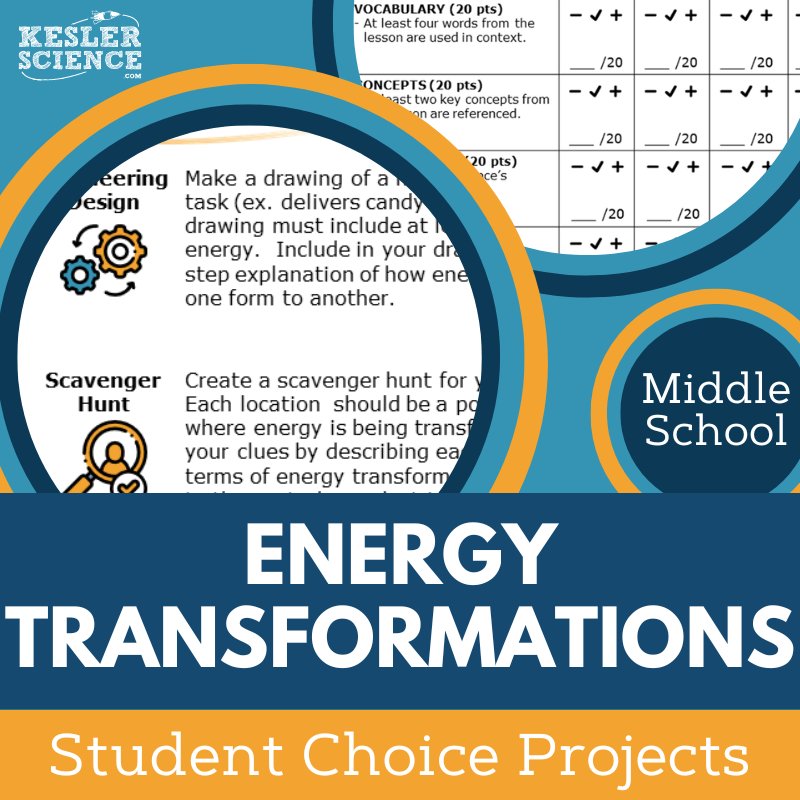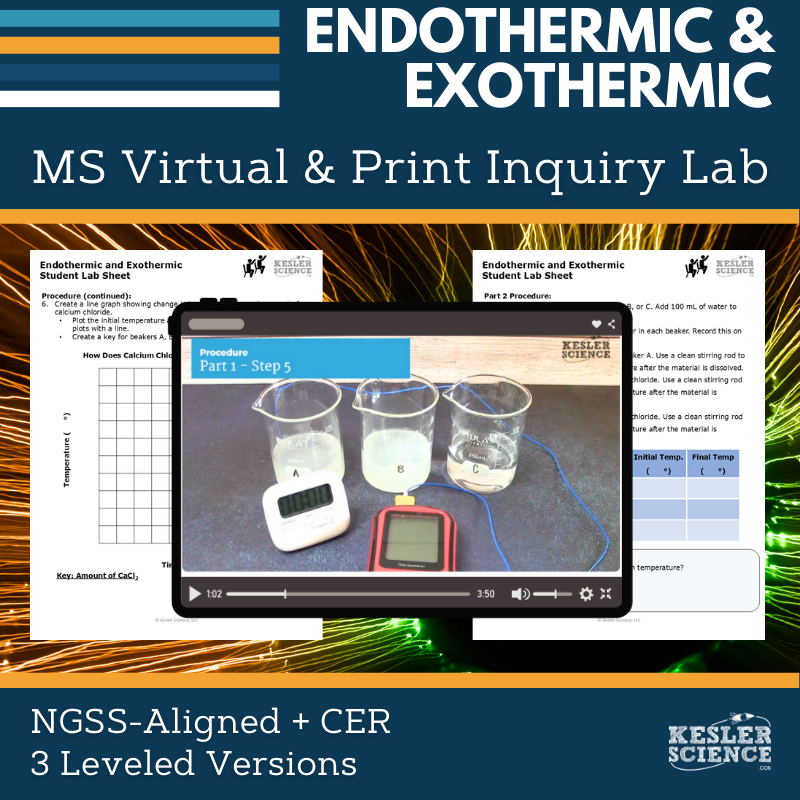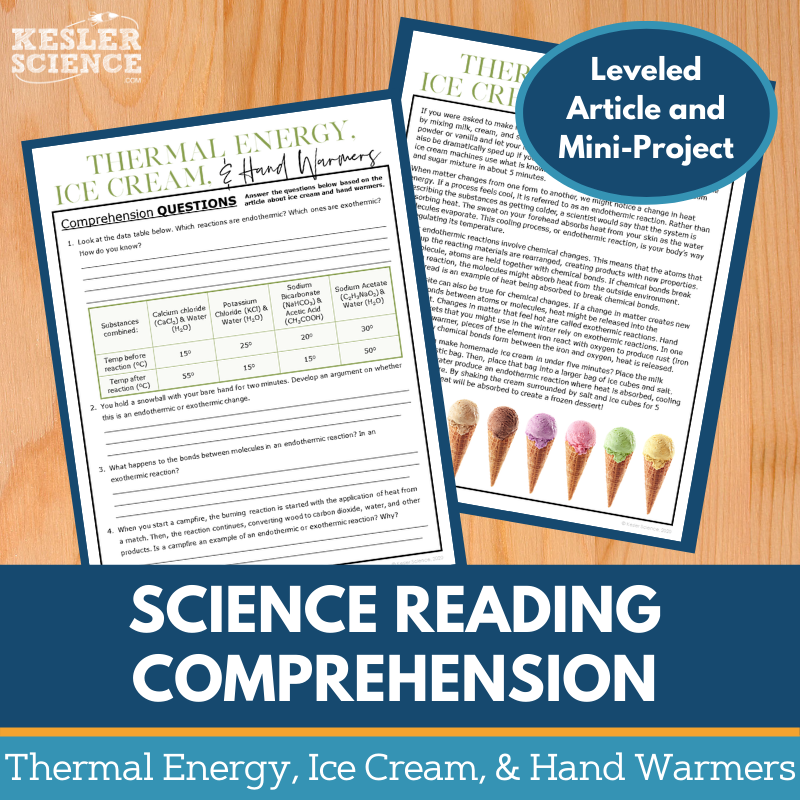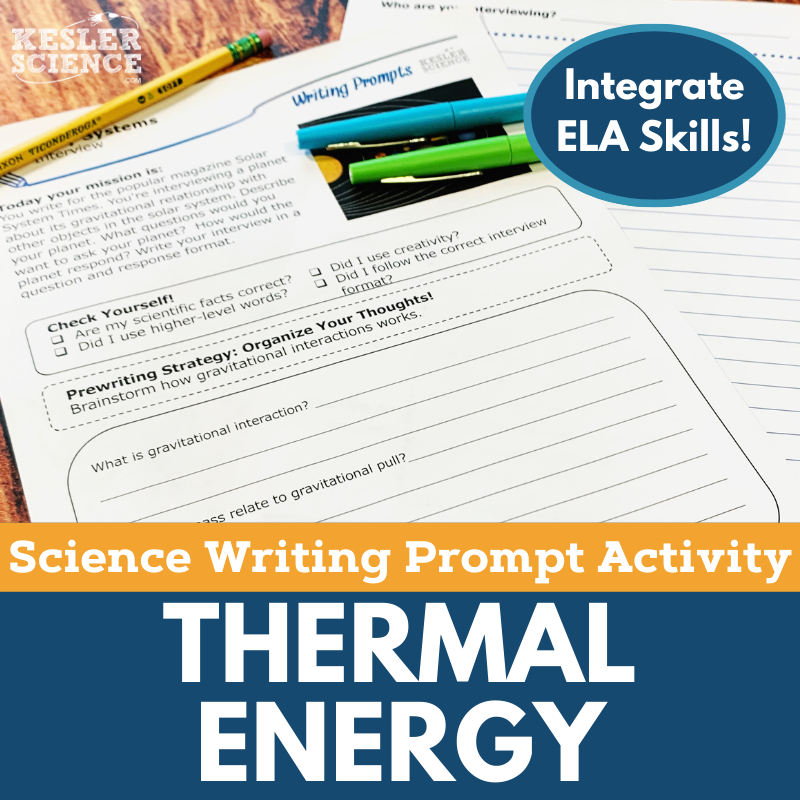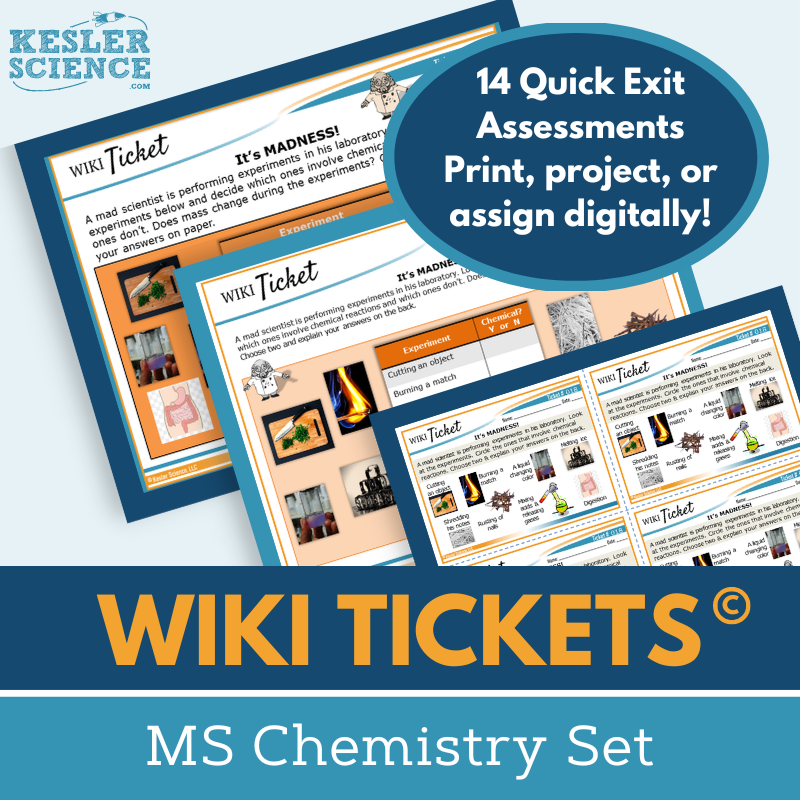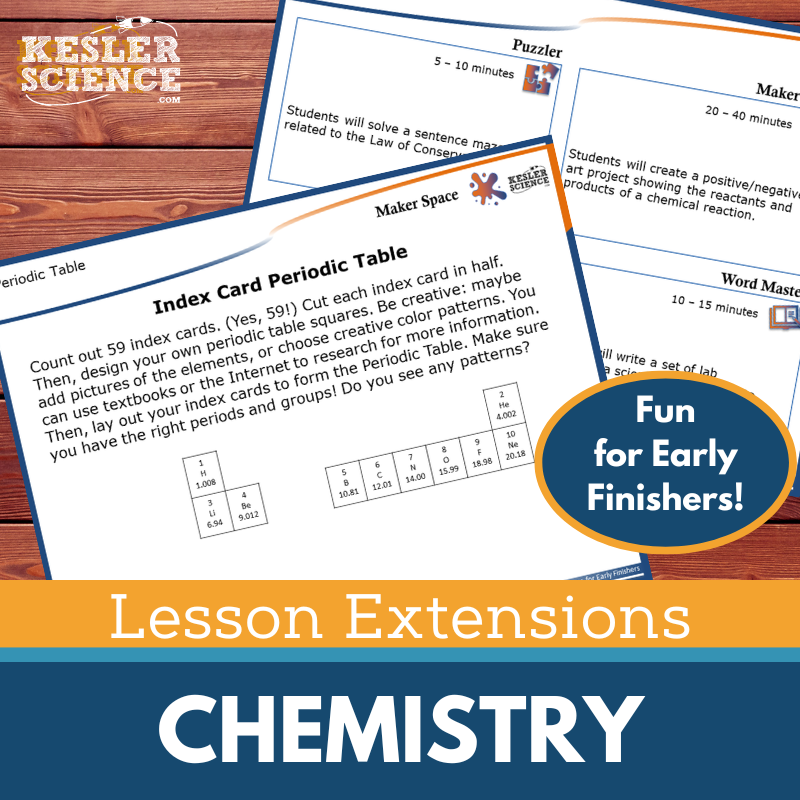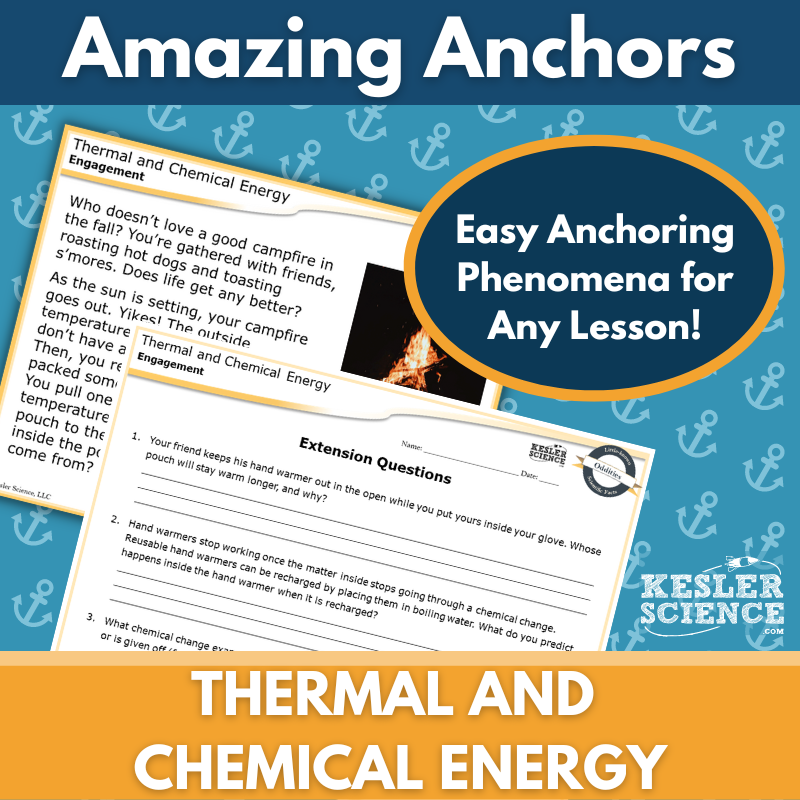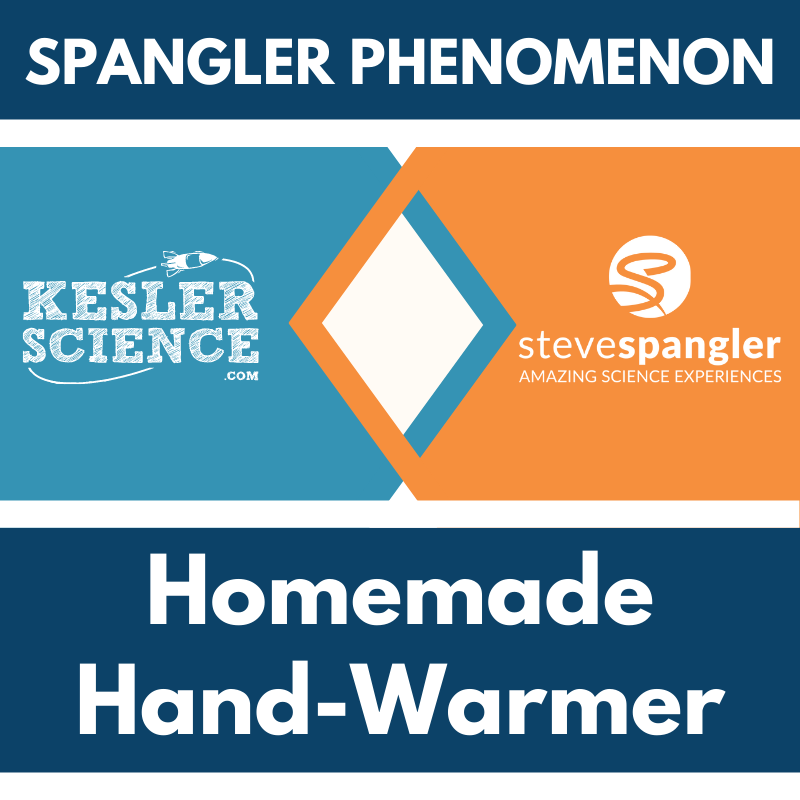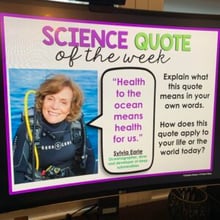Endothermic & Exothermic Activities for Middle School Science
The endothermic and exothermic 5E Lessons are engaging, fully editable middle school science units designed for differentiated, student-led learning. The resources below will give students a comprehensive understanding of endothermic and exothermic reactions. All of the following materials are also included in the Kesler Science Membership.
The Kesler Science Conduction, Convection, and Radiation 5E Lesson is a fully editable, engaging middle school unit with presentations, worksheets, choice projects, and assessments requiring minimal prep. Designed for differentiated, student-led learning, it aligns with NGSS and TEKS standards and includes Spanish translations of key materials.
The unit follows the 5E Model, beginning with engagement activities, word wall cards, and discussion prompts. The exploration phase features a student-led station lab with multimodal input and output activities, including hands-on demos, reading passages, videos, and digital interactions. Explanation includes editable PowerPoints, interactive notebooks, and note-taking templates. Elaboration allows students to extend learning through choice projects, while evaluation includes STAAR 2.0-aligned assessments, review questions, and worksheets.
With flexible formats for printable and digital use, this lesson supports both in-class and virtual learning environments.
The Kesler Science Conduction, Convection, and Radiation 5E Lesson is a fully editable, engaging middle school unit with presentations, worksheets, choice projects, and assessments requiring minimal prep. Designed for differentiated, student-led learning, it aligns with NGSS and TEKS standards and includes Spanish translations of key materials.
The unit follows the 5E Model, beginning with engagement activities, word wall cards, and discussion prompts. The exploration phase features a student-led station lab with multimodal input and output activities, including hands-on demos, reading passages, videos, and digital interactions. Explanation includes editable PowerPoints, interactive notebooks, and note-taking templates. Elaboration allows students to extend learning through choice projects, while evaluation includes STAAR 2.0-aligned assessments, review questions, and worksheets.
With flexible formats for printable and digital use, this lesson supports both in-class and virtual learning environments.
The Kesler Science Energy Transformations 5E Lesson is a comprehensive, student-led unit designed for middle school science classrooms. It includes editable presentations, worksheets, choice projects, and assessments, requiring minimal prep while promoting differentiated learning. The lesson aligns with NGSS and TEKS standards and follows the 5E Model: Engagement, Exploration, Explanation, Elaboration, and Evaluation.
Students engage with vocabulary word wall cards, teacher-led discussions, and activities addressing common misconceptions. The hands-on station lab provides nine multimodal stations, including experiments, reading passages in English and Spanish, research tasks, videos, and interactive categorization exercises. Students demonstrate understanding through written responses, illustrations, and assessments. A bonus challenge station extends learning for early finishers.
Explanation materials include editable PowerPoints, interactive notebooks in multiple formats, and structured note-taking templates. Student-choice projects in the elaboration phase allow for deeper exploration of energy transformations, while assessments aligned with STAAR 2.0 provide evaluation opportunities. The lesson is flexible for both in-person and virtual learning, with digital and printable options available.
The Kesler Science Energy Transformations 5E Lesson is a comprehensive, student-led unit designed for middle school science classrooms. It includes editable presentations, worksheets, choice projects, and assessments, requiring minimal prep while promoting differentiated learning. The lesson aligns with NGSS and TEKS standards and follows the 5E Model: Engagement, Exploration, Explanation, Elaboration, and Evaluation.
Students engage with vocabulary word wall cards, teacher-led discussions, and activities addressing common misconceptions. The hands-on station lab provides nine multimodal stations, including experiments, reading passages in English and Spanish, research tasks, videos, and interactive categorization exercises. Students demonstrate understanding through written responses, illustrations, and assessments. A bonus challenge station extends learning for early finishers.
Explanation materials include editable PowerPoints, interactive notebooks in multiple formats, and structured note-taking templates. Student-choice projects in the elaboration phase allow for deeper exploration of energy transformations, while assessments aligned with STAAR 2.0 provide evaluation opportunities. The lesson is flexible for both in-person and virtual learning, with digital and printable options available.
Engage your middle school students with this student-led station lab on conduction, convection, and radiation. Designed to encourage independent learning, this modular activity helps students develop a model predicting and describing changes in particle motion, temperature, and state of pure substances.
This lab includes nine interactive stations, each with differentiated activities to support various learning styles. Input stations introduce concepts through hands-on demonstrations, research, reading passages (available in English and Spanish), and videos. Output stations allow students to demonstrate their understanding by organizing information, illustrating models, writing responses, and completing assessments. A bonus challenge station provides extension activities for early finishers.
With all necessary signage, literature, resources, and task cards included, students can work independently or in small groups, whether in class or virtually. This low-prep, high-engagement resource fosters active learning and critical thinking.
Engage your middle school students with this student-led station lab on conduction, convection, and radiation. Designed to encourage independent learning, this modular activity helps students develop a model predicting and describing changes in particle motion, temperature, and state of pure substances.
This lab includes nine interactive stations, each with differentiated activities to support various learning styles. Input stations introduce concepts through hands-on demonstrations, research, reading passages (available in English and Spanish), and videos. Output stations allow students to demonstrate their understanding by organizing information, illustrating models, writing responses, and completing assessments. A bonus challenge station provides extension activities for early finishers.
With all necessary signage, literature, resources, and task cards included, students can work independently or in small groups, whether in class or virtually. This low-prep, high-engagement resource fosters active learning and critical thinking.
Engage your middle school students with this student-led Energy Transformations Station Lab, designed to foster independent learning and critical thinking. Through interactive stations, students explore the relationships between energy transfer, mass, matter type, and kinetic energy.
This modular lab includes nine differentiated stations, allowing students to learn in various ways. Input stations introduce energy transformation concepts through hands-on demonstrations, research, reading, and video analysis. Output stations enable students to showcase their understanding by organizing information, illustrating models, writing responses, and completing assessments. A challenge station provides extension activities for early finishers.
All necessary signage, literature, task cards, and resources are included for independent or small-group learning, with minimal additional materials needed. This lab is adaptable for both in-class and virtual learning, ensuring flexibility for any teaching environment.
Engage your middle school students with this student-led Energy Transformations Station Lab, designed to foster independent learning and critical thinking. Through interactive stations, students explore the relationships between energy transfer, mass, matter type, and kinetic energy.
This modular lab includes nine differentiated stations, allowing students to learn in various ways. Input stations introduce energy transformation concepts through hands-on demonstrations, research, reading, and video analysis. Output stations enable students to showcase their understanding by organizing information, illustrating models, writing responses, and completing assessments. A challenge station provides extension activities for early finishers.
All necessary signage, literature, task cards, and resources are included for independent or small-group learning, with minimal additional materials needed. This lab is adaptable for both in-class and virtual learning, ensuring flexibility for any teaching environment.
The Conduction, Convection, and Radiation Student Choice Projects lesson allows middle school students to select a project that aligns with their preferred output style. A project page outlines six student-led options plus a “design your own” project, with an editable rubric for teacher, peer, or self-assessment.
These flexible, multimodal projects provide creative ways for students to demonstrate their understanding. Two versions of the project page support differentiation, with modified options for students needing remediation and challenge opportunities for advanced learners. Teachers can adjust the rubric to fit grading needs.
The projects use standard classroom supplies such as paper, markers, and scissors, with many options available for digital completion. Some crafting supplies may be helpful for building models.
The Conduction, Convection, and Radiation Student Choice Projects lesson allows middle school students to select a project that aligns with their preferred output style. A project page outlines six student-led options plus a “design your own” project, with an editable rubric for teacher, peer, or self-assessment.
These flexible, multimodal projects provide creative ways for students to demonstrate their understanding. Two versions of the project page support differentiation, with modified options for students needing remediation and challenge opportunities for advanced learners. Teachers can adjust the rubric to fit grading needs.
The projects use standard classroom supplies such as paper, markers, and scissors, with many options available for digital completion. Some crafting supplies may be helpful for building models.
The Energy Transformations Student Choice Projects align with NGSS science standards, allowing middle school students to demonstrate their understanding through a variety of creative formats. A project page outlines six student-led options plus a “design your own” project, all with an editable rubric for teacher, peer, or self-assessment.
These flexible, multimodal projects support differentiated learning with two versions of the project page—one offering modified options for students needing remediation and another allowing teachers to challenge advanced learners by assigning multiple projects using the same rubric.
Teachers can easily adapt the rubric to fit their grading needs. The projects use standard classroom supplies like paper, markers, and scissors, with many options available for digital completion. Some crafting supplies may be useful for building models.
The Energy Transformations Student Choice Projects align with NGSS science standards, allowing middle school students to demonstrate their understanding through a variety of creative formats. A project page outlines six student-led options plus a “design your own” project, all with an editable rubric for teacher, peer, or self-assessment.
These flexible, multimodal projects support differentiated learning with two versions of the project page—one offering modified options for students needing remediation and another allowing teachers to challenge advanced learners by assigning multiple projects using the same rubric.
Teachers can easily adapt the rubric to fit their grading needs. The projects use standard classroom supplies like paper, markers, and scissors, with many options available for digital completion. Some crafting supplies may be useful for building models.
The Endothermic and Exothermic Science Inquiry Lab aligns with NGSS MS-PS1-6, guiding students through a design project to construct, test, and modify a device that releases or absorbs thermal energy using chemical processes. This lab offers both hands-on and virtual options, allowing students to either conduct the experiment with printed materials or follow along with a pre-recorded video demonstration.
Students will design a device to cool or warm a glowstick, selecting chemicals to test and manipulating a variable to observe its effects. The lab includes comprehension questions, Claim-Evidence-Reasoning (C.E.R.) prompts, and a reflection section. Differentiation is built into three levels: Dependent (guided with inquiry questions), Modified (structured with sentence stems and multiple-choice options), and Independent (student-led with minimal guidance).
The print version provides hands-on procedures, requiring materials such as beakers, a thermometer, calcium chloride, ammonium chloride, and glowsticks. The digital version is an interactive PowerPoint compatible with Google Slides and major LMS platforms, featuring built-in virtual activities and a video demonstration of the procedure.
Teacher resources include editable PowerPoints, answer keys, CER statements, and teacher guidance pages. With flexible print and digital formats, this lab engages students in an interactive exploration of chemical energy transfer.
The Endothermic and Exothermic Science Inquiry Lab aligns with NGSS MS-PS1-6, guiding students through a design project to construct, test, and modify a device that releases or absorbs thermal energy using chemical processes. This lab offers both hands-on and virtual options, allowing students to either conduct the experiment with printed materials or follow along with a pre-recorded video demonstration.
Students will design a device to cool or warm a glowstick, selecting chemicals to test and manipulating a variable to observe its effects. The lab includes comprehension questions, Claim-Evidence-Reasoning (C.E.R.) prompts, and a reflection section. Differentiation is built into three levels: Dependent (guided with inquiry questions), Modified (structured with sentence stems and multiple-choice options), and Independent (student-led with minimal guidance).
The print version provides hands-on procedures, requiring materials such as beakers, a thermometer, calcium chloride, ammonium chloride, and glowsticks. The digital version is an interactive PowerPoint compatible with Google Slides and major LMS platforms, featuring built-in virtual activities and a video demonstration of the procedure.
Teacher resources include editable PowerPoints, answer keys, CER statements, and teacher guidance pages. With flexible print and digital formats, this lab engages students in an interactive exploration of chemical energy transfer.
This Science Reading Comprehension Passage helps students explore the release and absorption of thermal energy in chemical processes through a nonfiction article about thermal energy, ice cream, and hand warmers. Designed for middle school, the leveled passage supports science literacy and reading comprehension.
The resource includes two Lexile-leveled articles (1100-1300), five to seven comprehension questions, and a hands-on mini-project where students create a device that produces or removes heat. A Cornell notes template is also provided.
Ideal for sub plans, ISS, extra credit, or whole-class instruction, this resource fosters critical thinking, classroom discussions, and textual analysis. It is compatible with digital learning platforms like Google Classroom, MS Teams, Schoology, and Canvas, allowing students to complete assignments in-person or remotely.
This Science Reading Comprehension Passage helps students explore the release and absorption of thermal energy in chemical processes through a nonfiction article about thermal energy, ice cream, and hand warmers. Designed for middle school, the leveled passage supports science literacy and reading comprehension.
The resource includes two Lexile-leveled articles (1100-1300), five to seven comprehension questions, and a hands-on mini-project where students create a device that produces or removes heat. A Cornell notes template is also provided.
Ideal for sub plans, ISS, extra credit, or whole-class instruction, this resource fosters critical thinking, classroom discussions, and textual analysis. It is compatible with digital learning platforms like Google Classroom, MS Teams, Schoology, and Canvas, allowing students to complete assignments in-person or remotely.
The Thermal Energy Science Writing Prompt Activity engages middle school students in a creative journal entry exercise to reinforce their understanding of thermal energy. Aligned with NGSS MS-PS1-6, this student-centered activity challenges learners to undertake a design project that involves constructing, testing, and modifying a device that absorbs or releases thermal energy through chemical processes. Designed for both in-person and virtual learning, this low-prep resource supports science reasoning, exploration, and writing skills.
This resource includes teacher directions with an answer guide, project ideas, and rubrics, along with projection and print handouts in full-sized and half-sheet formats. A digital interactive version is available in PowerPoint and Google Slides for remote or in-class use. The writing activity is ideal for cross-curricular integration, pre-test assessments, student choice projects, early finisher tasks, extra credit, make-up work, differentiation, and TELPAS samples.
Perfect for display on bulletin boards or compiling into student anthologies, this writing prompt provides an engaging way for students to apply their knowledge of thermal energy. As a review activity, it assumes students have prior knowledge of the topic or access to research materials.
The Thermal Energy Science Writing Prompt Activity engages middle school students in a creative journal entry exercise to reinforce their understanding of thermal energy. Aligned with NGSS MS-PS1-6, this student-centered activity challenges learners to undertake a design project that involves constructing, testing, and modifying a device that absorbs or releases thermal energy through chemical processes. Designed for both in-person and virtual learning, this low-prep resource supports science reasoning, exploration, and writing skills.
This resource includes teacher directions with an answer guide, project ideas, and rubrics, along with projection and print handouts in full-sized and half-sheet formats. A digital interactive version is available in PowerPoint and Google Slides for remote or in-class use. The writing activity is ideal for cross-curricular integration, pre-test assessments, student choice projects, early finisher tasks, extra credit, make-up work, differentiation, and TELPAS samples.
Perfect for display on bulletin boards or compiling into student anthologies, this writing prompt provides an engaging way for students to apply their knowledge of thermal energy. As a review activity, it assumes students have prior knowledge of the topic or access to research materials.
The WIKI Tickets© Chemistry Set provides engaging, flexible formative assessments for 6th-8th grade science, offering multiple ways to check student understanding. This set includes 14 topics, each available in five formats: a full-screen projection version, three printable handout sizes, and an interactive digital version compatible with PowerPoint and Google Slides.
Aligned with NGSS and TEKS standards, these assessments ensure comprehensive coverage, with some topics featuring multiple tickets. A bonus table of contents file is included for easy alignment reference. Designed for both in-person and virtual learning, WIKI Tickets© can be used as exit tickets, bellringers, or quick checks. Students can respond on their own paper, printed handouts, or digital copies in a 1:1 or remote setting.
Covering key topics such as atomic structure, chemical changes, density, and periodic table arrangement, these colorful assessments help you gauge student progress in an engaging way.
The WIKI Tickets© Chemistry Set provides engaging, flexible formative assessments for 6th-8th grade science, offering multiple ways to check student understanding. This set includes 14 topics, each available in five formats: a full-screen projection version, three printable handout sizes, and an interactive digital version compatible with PowerPoint and Google Slides.
Aligned with NGSS and TEKS standards, these assessments ensure comprehensive coverage, with some topics featuring multiple tickets. A bonus table of contents file is included for easy alignment reference. Designed for both in-person and virtual learning, WIKI Tickets© can be used as exit tickets, bellringers, or quick checks. Students can respond on their own paper, printed handouts, or digital copies in a 1:1 or remote setting.
Covering key topics such as atomic structure, chemical changes, density, and periodic table arrangement, these colorful assessments help you gauge student progress in an engaging way.
Lesson Extensions provide engaging, student-choice activities designed to challenge early finishers while reinforcing critical thinking and creativity. These activities help wrap up lessons, fill downtime during testing, and keep students engaged with rigorous yet enjoyable learning opportunities aligned to NGSS and TEKS chemistry standards.
Each extension includes four interactive components: Puzzler for problem-solving, Maker Space for hands-on STEAM activities, Tech Connection for digital media demonstrations, and Word Master for creative writing. Teacher directions, answer keys, and both print and projection versions ensure flexibility in the classroom.
Covering topics such as atomic structures, chemical reactions, the periodic table, and synthetic materials, these extensions provide high-level enrichment for independent learners ready to explore chemistry concepts more deeply.
Lesson Extensions provide engaging, student-choice activities designed to challenge early finishers while reinforcing critical thinking and creativity. These activities help wrap up lessons, fill downtime during testing, and keep students engaged with rigorous yet enjoyable learning opportunities aligned to NGSS and TEKS chemistry standards.
Each extension includes four interactive components: Puzzler for problem-solving, Maker Space for hands-on STEAM activities, Tech Connection for digital media demonstrations, and Word Master for creative writing. Teacher directions, answer keys, and both print and projection versions ensure flexibility in the classroom.
Covering topics such as atomic structures, chemical reactions, the periodic table, and synthetic materials, these extensions provide high-level enrichment for independent learners ready to explore chemistry concepts more deeply.
This Amazing Anchors Phenomenon Lesson engages students in exploring thermal and chemical energy through the relatable experience of making s’mores. The lesson begins with an introductory reading that sets the stage for learning, followed by comprehension and extension questions to encourage critical thinking. An explanatory reading then breaks down the scientific principles behind thermal and chemical energy, reinforcing key concepts with additional comprehension and reinforcement questions.
Designed to align with NGSS (MS PS1-6) and TEKS standards, this no-prep resource includes teacher directions, answer keys, and multiple formats to support different classroom needs. A projection version allows for easy classroom display, while print options offer full- and half-sheet handouts that integrate well with interactive notebooks. A digital version is also available, allowing students to engage with the material through Google Classroom or other LMS platforms.
To support diverse learners, this lesson includes a modified version with differentiated language and sentence starters to assist students in answering comprehension questions. Ideal for the Engagement and Elaborate phases of a 5E lesson, this resource serves as a meaningful supplement to any unit on energy. Whether used in-person or virtually, this Amazing Anchors lesson provides a structured yet flexible approach to reinforcing key science concepts.
This Amazing Anchors Phenomenon Lesson engages students in exploring thermal and chemical energy through the relatable experience of making s’mores. The lesson begins with an introductory reading that sets the stage for learning, followed by comprehension and extension questions to encourage critical thinking. An explanatory reading then breaks down the scientific principles behind thermal and chemical energy, reinforcing key concepts with additional comprehension and reinforcement questions.
Designed to align with NGSS (MS PS1-6) and TEKS standards, this no-prep resource includes teacher directions, answer keys, and multiple formats to support different classroom needs. A projection version allows for easy classroom display, while print options offer full- and half-sheet handouts that integrate well with interactive notebooks. A digital version is also available, allowing students to engage with the material through Google Classroom or other LMS platforms.
To support diverse learners, this lesson includes a modified version with differentiated language and sentence starters to assist students in answering comprehension questions. Ideal for the Engagement and Elaborate phases of a 5E lesson, this resource serves as a meaningful supplement to any unit on energy. Whether used in-person or virtually, this Amazing Anchors lesson provides a structured yet flexible approach to reinforcing key science concepts.
The Spangler Phenomenon lesson on thermal energy and chemical processes features an exclusive Steve Spangler video designed to captivate students and spark their analytical thinking with the guiding question: Why is a hand warmer designed the way it is?
Aligned with the 5E framework and NGSS standards, this lesson engages students in three phases. In Think Like a Scientist, students explore thermal energy and chemical processes through an inspiring Steve Spangler video and build their own hand warmers. In Study Like a Scientist, they analyze an engaging article on the topic, with opportunities to incorporate additional experiments. In Work Like a Scientist, students refine their conclusions after watching an exclusive explanation video and demonstrate their learning through writing, drawing, or building activities.
This lesson includes teacher directions with materials lists and answer keys, student handouts, two Steve Spangler videos, presentation slides in standard and digital formats, and PowerPoints optimized for Google Slides. Vimeo links ensure an ad-free viewing experience.
Available in PowerPoint and PDF formats, this engaging lesson is part of an exciting collaboration between Kesler Science and Steve Spangler.
The Spangler Phenomenon lesson on thermal energy and chemical processes features an exclusive Steve Spangler video designed to captivate students and spark their analytical thinking with the guiding question: Why is a hand warmer designed the way it is?
Aligned with the 5E framework and NGSS standards, this lesson engages students in three phases. In Think Like a Scientist, students explore thermal energy and chemical processes through an inspiring Steve Spangler video and build their own hand warmers. In Study Like a Scientist, they analyze an engaging article on the topic, with opportunities to incorporate additional experiments. In Work Like a Scientist, students refine their conclusions after watching an exclusive explanation video and demonstrate their learning through writing, drawing, or building activities.
This lesson includes teacher directions with materials lists and answer keys, student handouts, two Steve Spangler videos, presentation slides in standard and digital formats, and PowerPoints optimized for Google Slides. Vimeo links ensure an ad-free viewing experience.
Available in PowerPoint and PDF formats, this engaging lesson is part of an exciting collaboration between Kesler Science and Steve Spangler.
Year-Round Resources
These year-round activities will increase your students' understanding of many middle school science topics. All of these activities are also included in the Kesler Science Membership.
Visual Data & Graphing
You're not alone if your students struggle with understanding graphs, charts, and tables. It's a skill that takes an enormous amount of practice. This resource will help students build a strong foundation in analyzing data and creating their own data visualizations.
Bell Ringers and Warm-Ups
These middle school science bell ringers are an excellent way to engage your students as soon as they walk into your classroom. This comprehensive FULL YEAR resource includes everything you need to start off each science class with an interesting warm-up activity.
Review Board Games
Each game board has been carefully designed to keep students engaged. There are 10 different action spaces on each board and dozens of question cards. All of the actions are related to science concepts and keep the students motivated throughout the game.
Each game is ready to play. Simply print out the board and the cards and let the students enjoy reviewing nine different units.
Essential Questions and Standards
Below are the essential questions and standards associated with the lessons and activities included in the endothermic and exothermic unit. This topic is only one of more than 100 middle school science topics included in the Kesler Science Membership.
-
What methods can be used to demonstrate thermal energy?
-
What are conduction, convection, and radiation, including examples?
-
How can you demonstrate energy transformations?
-
NGSS - MS-PS1-6 Endothermic & Exothermic
Kesler Science Membership
Imagine never having to search for another middle school science lesson again. The membership gives you access to ALL of the Kesler Science products in one place (Yes, including everything above).
Say goodbye to long hours of lesson prep.

